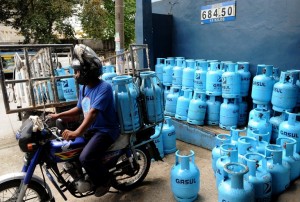
A man delivers cylinders of liquefied petroleum gas in Manila in this 2011 file photo. Under the Philippine government’s credit surety fund (CSF) program, loans to microenterprises may accelerate and hit the P1-billion mark by the end of 2012 .AFP PHOTO/JAY DIRECTO
MANILA, Philippines—Loans to microenterprises under the government’s credit surety fund (CSF) program are expected to hit the P1-billion mark by the end of the year.
According to the Bangko Sentral ng Pilipinas (BSP), the government is bent on increasing financial assistance to the microenterprises sector to attain an economic growth rate that will actually reduce the incidence of poverty.
Gary Maningo, program manager for the CSF program, which is spearheaded by the central bank, said that they were told to release loans amounting to P1 billion by the end of this year.
Since the CSF program started in 2008, a total of P271 million had been released by the 22 CSFs nationwide.
Maningo said the amount of loan disbursements should increase in the months ahead due to the rise in the number of CSFs.
“Although the program started in 2008, lending activities have started to pick up only recently,” Maningo told the Inquirer at the sidelines of a BSP briefing on economic developments held Saturday at Subic Bay.
A CSF is a pool of funds from state-owned banks, local governments, cooperatives, and nongovernment organizations that is used to serve as collateral for bank loans secured by microenterprises.
The objective of the CSF program is to make loans accessible for small businesses. Most small traders find it difficult to borrow from banks because they lack assets that can serve as collateral.
But with the CSF, 80 percent of the loan secured by the borrower is guaranteed. Central bank officials said the guarantee encourages banks to lend to microenterprises.
Maningo said the rise in loans for microenterprises would complement the government’s medium-term goal of increasing the contributions of micro, small and medium enterprises (MSME) sector to the Philippine economy from the current 35 percent to 40 percent.
Estimates showed that there are about 800,000 enterprises in the country, of which about 600,000 are MSMEs.
Central bank officials said supporting growth of microenterprises would be an effective way to address what economists describe as “non-inclusive economic growth” in the Philippines.
Economists explained that, although the Philippine economy has been growing over the years, the number of Filipinos living below the poverty line remains significant. As of 2009, poverty incidence stood at 26.5 percent. They said that only the middle class and the rich get to benefit from the economic growth of the Philippines.
One of the factors cited for the problem is the inability of the poor to access loans.
The BSP said that, through the CSF program, the country’s economic growth would become “inclusive.”—Michelle V. Remo